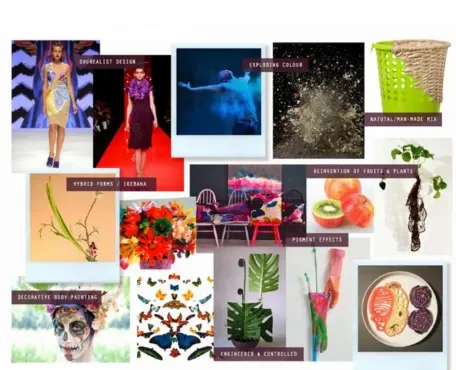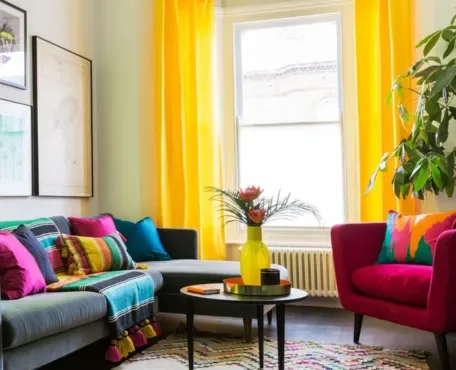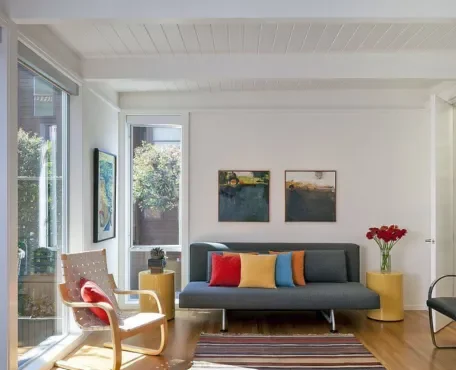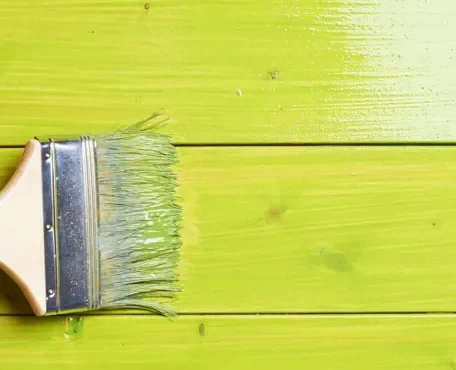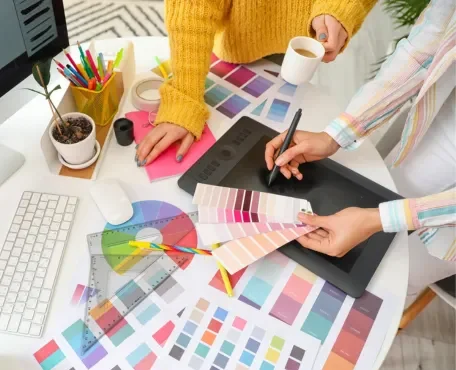
In the realm of interior design, creating visually engaging spaces is paramount. Accent walls and feature colors stand out as powerful tools in achieving this goal, allowing designers and homeowners alike to infuse personality, depth, and intrigue into a room.
From adding focal points to highlighting architectural elements, these techniques have the ability to transform ordinary spaces into extraordinary ones. In this comprehensive guide, we will delve into the concept of accent walls and feature colors, exploring their benefits, implementation strategies, and creative possibilities. Accent walls and feature colors serve multiple purposes, each contributing to the overall aesthetic and functionality of a space.
Here are some key benefits:
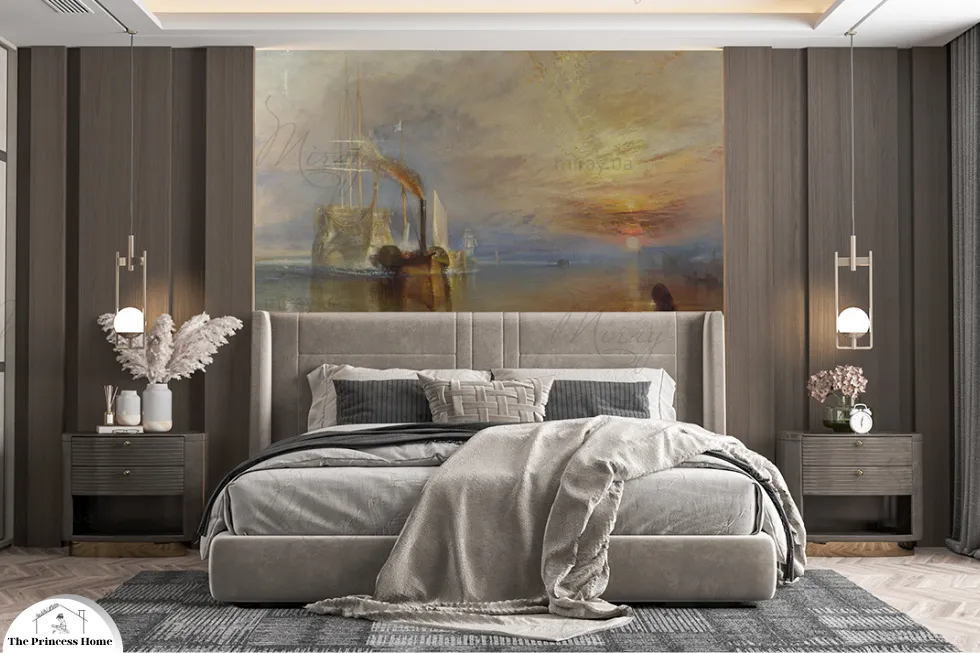
1*.The Purpose &Benefits:
1.Creating Focal Points:
Accent walls draw the eye and create focal points within a room, guiding the viewer’s gaze and emphasizing specific areas or architectural features.
Creating focal points is crucial in interior design, and accent walls serve as a powerful tool for this. By drawing the eye and highlighting specific areas, they enhance visual appeal and functionality. Whether through bold colors, striking patterns, or textured finishes, accent walls define focal points effectively.

2.Adding Depth and Dimension:
By introducing contrasting colors or textures, accent walls can add depth and dimension to a space, making it feel more dynamic and visually interesting.
Adding depth and dimension to a space is essential for creating a dynamic and visually engaging environment. Accent walls play a crucial role in achieving this by introducing contrasting colors or textures. By adding a different color or texture to one wall, accent walls create visual contrast and depth, making the space feel dynamic and interesting.
The interplay of light and shadow on the textured surface, or the mix of bold and neutral colors, enhances the room’s depth, making it appear more spacious and multi-dimensional. This technique boosts the overall aesthetic appeal, making the space visually stimulating and inviting for occupants and visitors.
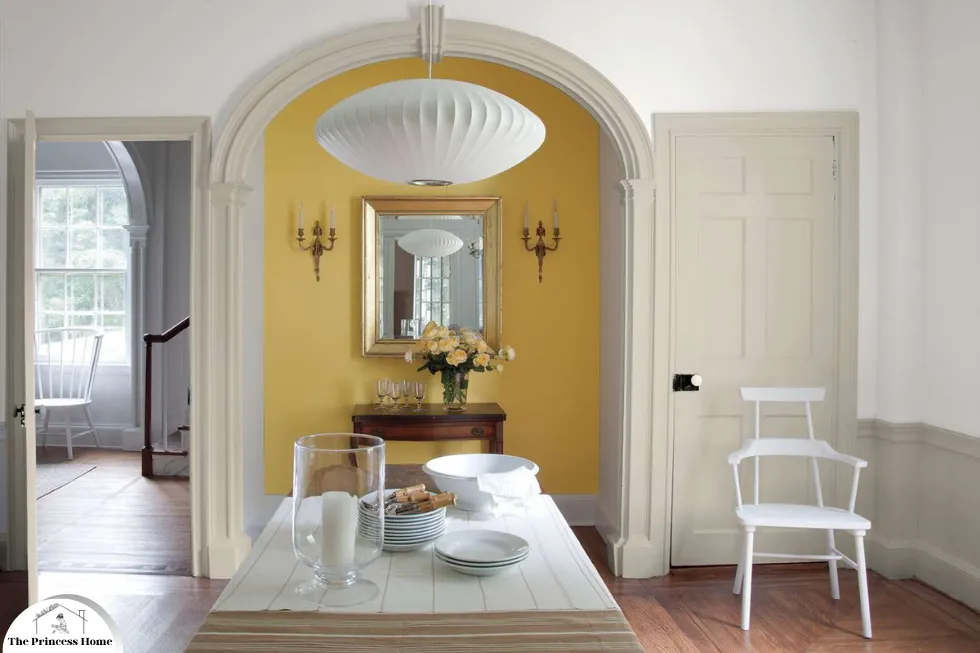
3.Highlighting Architectural Details:
Feature colors can be used to accentuate architectural elements such as alcoves, niches, or columns, bringing attention to these unique features and adding architectural interest.
Highlighting architectural details enhances a space’s visual appeal, with feature colors playing a crucial role. By strategically applying bold colors to elements like alcoves or columns, feature colors draw attention and enhance architectural interest. Whether painting a recessed alcove or contrasting a column against surrounding walls, feature colors create visual contrast, making architectural details focal points. This technique adds depth and character, showcasing architectural nuances for a more dynamic design scheme.
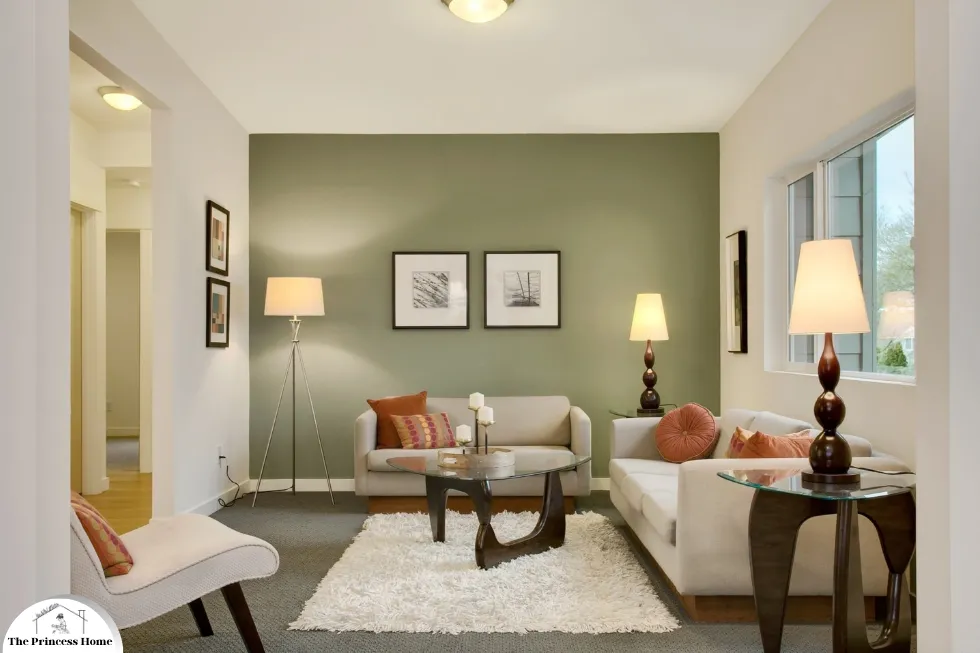
4.Enhancing Mood and Atmosphere:
The choice of colors can have a significant impact on the mood and atmosphere of a room. Feature colors can be used to evoke certain emotions or create specific atmospheres, whether it’s a calming sanctuary or an energizing workspace.
Enhancing the mood and atmosphere of a room is a crucial aspect of interior design, and feature colors play a pivotal role in achieving this. The choice of colors can profoundly impact the emotional and psychological experience of a space. By strategically selecting feature colors, designers can evoke specific emotions or create desired atmospheres within a room.
Soft pastel blues or muted greens can create a calming sanctuary, ideal for bedrooms or relaxation areas. Conversely, bold fiery reds or sunny yellows can infuse energy into a space, perfect for lively workspaces or creative studios. Feature colors offer a powerful means of shaping a room’s mood and atmosphere, aligning it with desired aesthetics and functionality.

2*.Implementation Strategies:
When incorporating accent walls and feature colors into your interior design scheme, consider the following strategies:
Choose the Right Wall:
Select a wall that naturally draws attention or serves as a focal point in the room, such as the wall behind a bed in a bedroom or the wall facing the entrance in a living room. When selecting a wall to focus on, it’s important to consider its natural prominence within the room.
Here’s how you can choose the right wall:
1.Identify the Focal Point:
Look for a wall that naturally draws attention or serves as a focal point in the room. This could be the wall behind the bed in a bedroom, the wall facing the entrance in a living room, or any wall with architectural features like a fireplace or large window.
2.Consider Functionality:
Ensure that the chosen wall complements the function of the room. For example, in a bedroom, the wall behind the bed is often the focal point as it anchors the sleeping area. In a living room, the wall facing the entrance is a common choice as it sets the tone for the rest of the space.
3.Evaluate Visual Impact:
Assess the visual impact of the wall in relation to the overall layout and design of the room. Choose a wall that enhances the aesthetic appeal and contributes to the desired atmosphere.
4.Highlight Architectural Features:
If the room has architectural features such as exposed brick, paneling, or alcoves, consider selecting a wall that showcases these elements to add character and interest.
5.Balance with Other Elements:
Ensure that the chosen wall balances with other design elements in the room, such as furniture arrangement, lighting, and decor. Avoid overwhelming the space by selecting a wall that complements the overall design scheme.
By carefully selecting the right wall to focus on, you can create a visually appealing and cohesive look that enhances the overall ambiance of the room.

3*.Consider the Room’s Function:
Tailor your choice of colors and design elements to suit the function of the room. For example, bold and vibrant colors may be suitable for a lively living room or dining area, while soothing hues may be more appropriate for a bedroom or relaxation space.
Certainly! Tailoring the choice of colors and design elements to suit the function of a room is crucial for creating the right atmosphere and ambiance.
Here’s a breakdown of how different colors and design elements can be chosen based on the room’s function:
1.Living Room/Dining Area:
Colors: Bold and vibrant colors such as rich reds, deep blues, or warm oranges can energize the space and encourage social interaction.
Design Elements: Incorporate statement pieces of furniture, lively patterns, and artwork to create a dynamic and welcoming environment.
2.Bedroom/Relaxation Space:
Colors: Soothing hues like soft blues, gentle greens, or muted pastels promote relaxation and tranquility, conducive to restful sleep.
Design Elements: Opt for comfortable furniture, plush textiles, and soft lighting to create a cozy and calming atmosphere perfect for unwinding.
3.Home Office/Study:
Colors: Neutral tones such as warm grays, soft browns, or creamy whites can enhance focus and productivity without overwhelming the space.
Design Elements: Choose functional furniture with ample storage, ergonomic seating, and adequate task lighting to support concentration and efficiency.
4.Kitchen:
Colors: Bright and cheerful colors like sunny yellows, crisp whites, or earthy tones can create an inviting and lively atmosphere conducive to cooking and gathering.
Design Elements: Incorporate practical storage solutions, durable materials, and efficient layouts to maximize functionality while maintaining aesthetic appeal.
5.Bathroom:
Colors: Clean and crisp colors such as pure whites, soft neutrals, or spa-like blues evoke a sense of cleanliness and serenity.
Design Elements: Focus on sleek fixtures, ample lighting, and storage solutions to create a serene and spa-like retreat for relaxation and rejuvenation.
By carefully selecting colors and design elements tailored to the function of each room, you can create spaces that not only look aesthetically pleasing but also serve their intended purpose effectively.
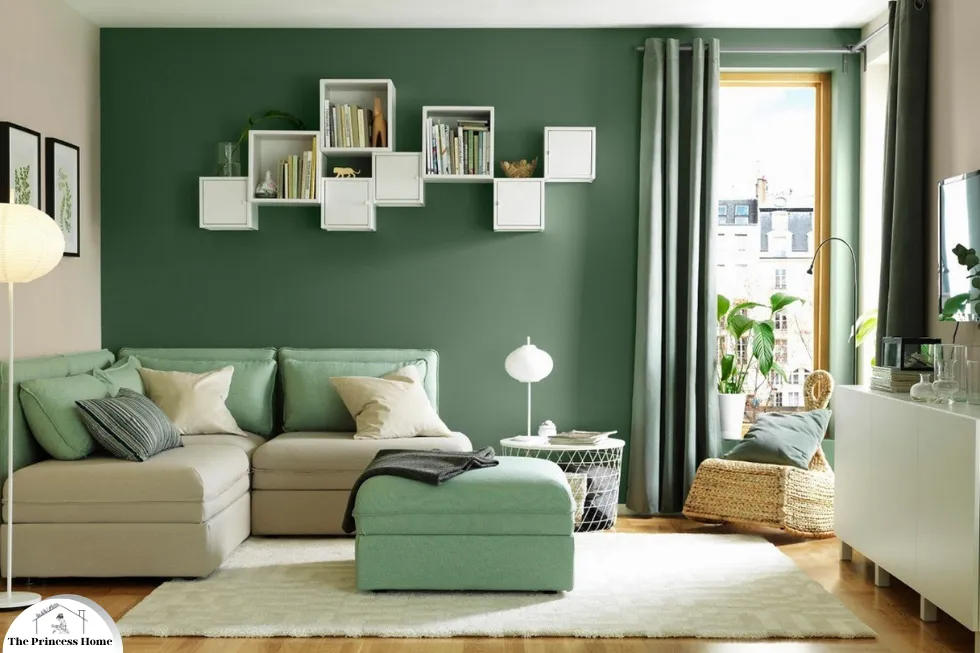
Experiment with Color Psychology:
Take into account the psychological effects of different colors and how they can influence the mood and atmosphere of a room. For instance, warm colors like red and orange can evoke feelings of energy and warmth, while cool colors like blue and green can create a sense of calm and serenity.
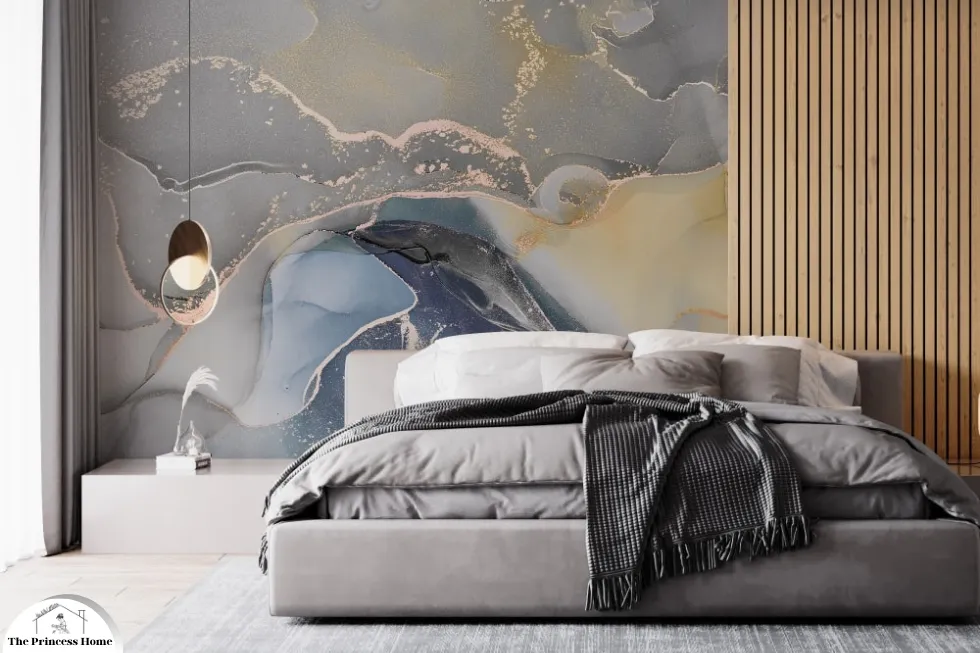
Layer Textures and Patterns:
Incorporate texture and pattern into your accent walls to add visual interest and depth. Consider using materials such as textured wallpaper, wood paneling, or decorative tiles to enhance the tactile and visual appeal of the wall.
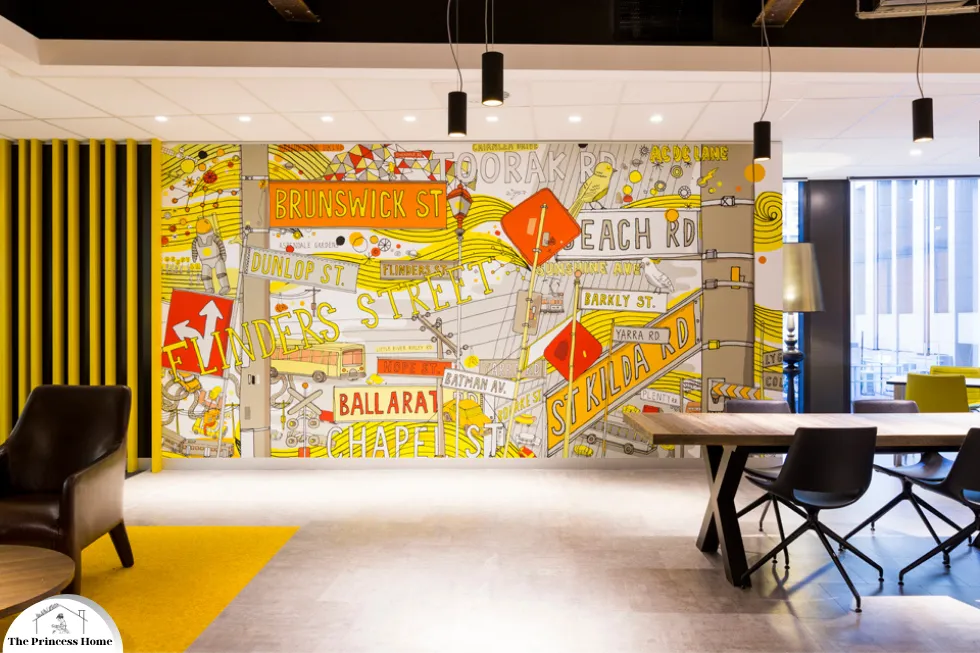
4*.Creative Possibilities:
The possibilities for accent walls and feature colors are endless, limited only by imagination. Here are some creative ideas to spark inspiration:

1.Bold Statement Walls:
Create a bold statement with dramatic colors or patterns, rich jewel tones, or striking geometric designs. Experiment with metallic finishes or textured paints for added impact.
To create a bold statement wall that grabs attention and adds drama to a room, consider the following tips:

2.Dramatic Colors:
Choose intense and captivating colors like deep blues, vibrant reds, or rich jewel tones. These colors instantly draw the eye and create a striking focal point in the room.
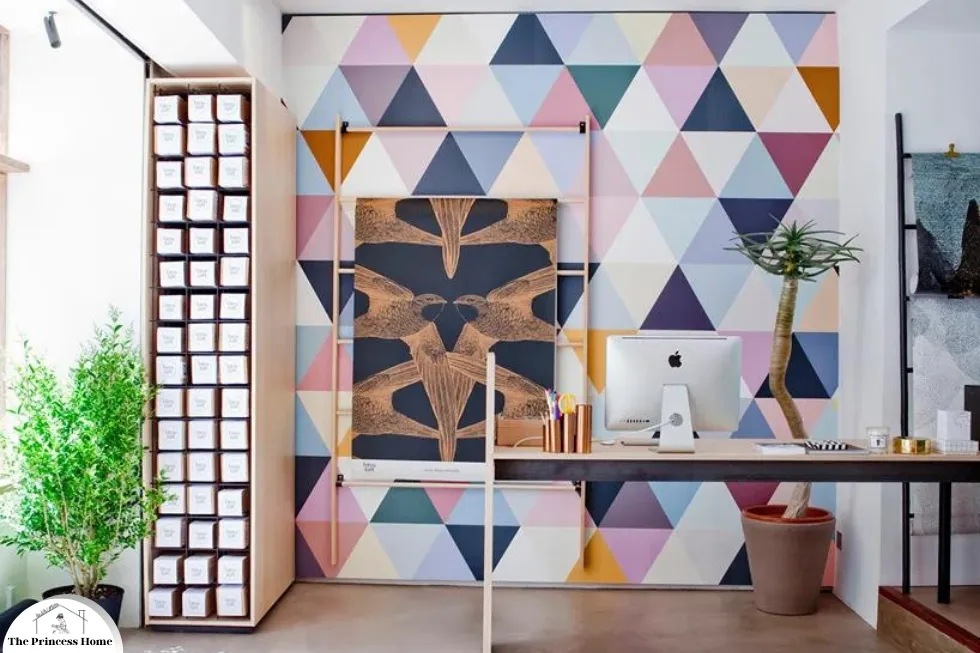
3.Bold Patterns:
Experiment with eye-catching patterns such as geometric designs, abstract motifs, or intricate wallpapers. These patterns inject personality and visual interest into the space, making the statement wall truly stand out.

4.Textured Finishes:
Opt for textured paints or wallpapers to add depth and dimension to the wall. Textured finishes can range from subtle to dramatic, offering tactile appeal and enhancing the overall visual impact of the statement wall.
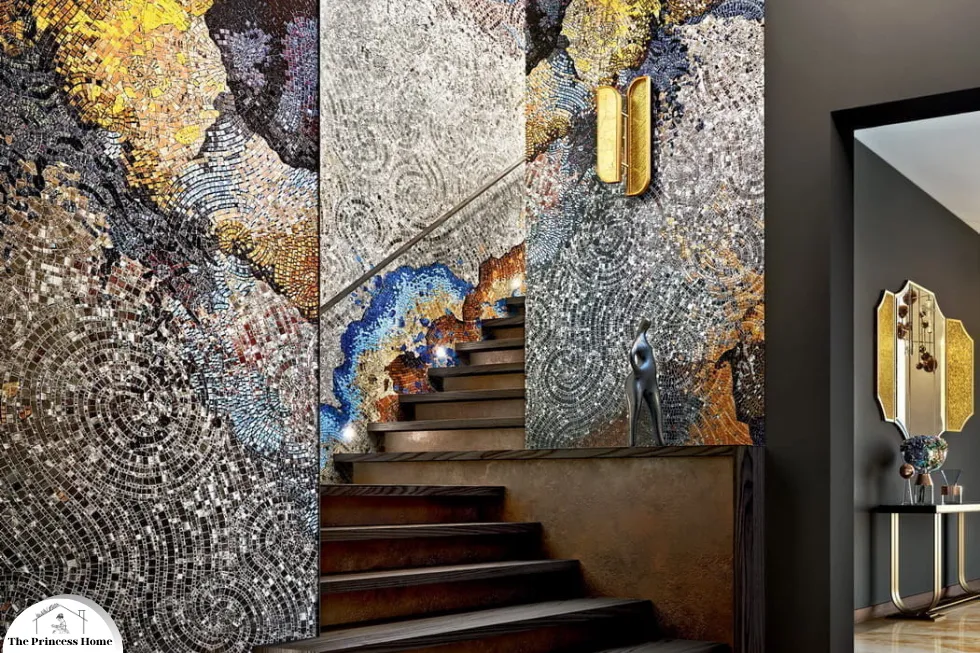
5.Metallic Accents:
Incorporate metallic finishes such as gold, silver, or copper to introduce a touch of luxury and glamour to the statement wall. Metallic accents catch and reflect light, adding shimmer and sophistication to the room.

6.Contrast and Balance:
Pair bold statement walls with complementary elements to achieve balance in the room. Consider using neutral or muted colors for the surrounding walls and furnishings to allow the statement wall to take center stage without overwhelming the space.

7.Lighting Considerations:
Pay attention to lighting to highlight the bold statement wall effectively. Consider adding wall sconces, recessed lighting, or accent lighting to illuminate the wall and enhance its visual impact, especially during the evening or in rooms with limited natural light.
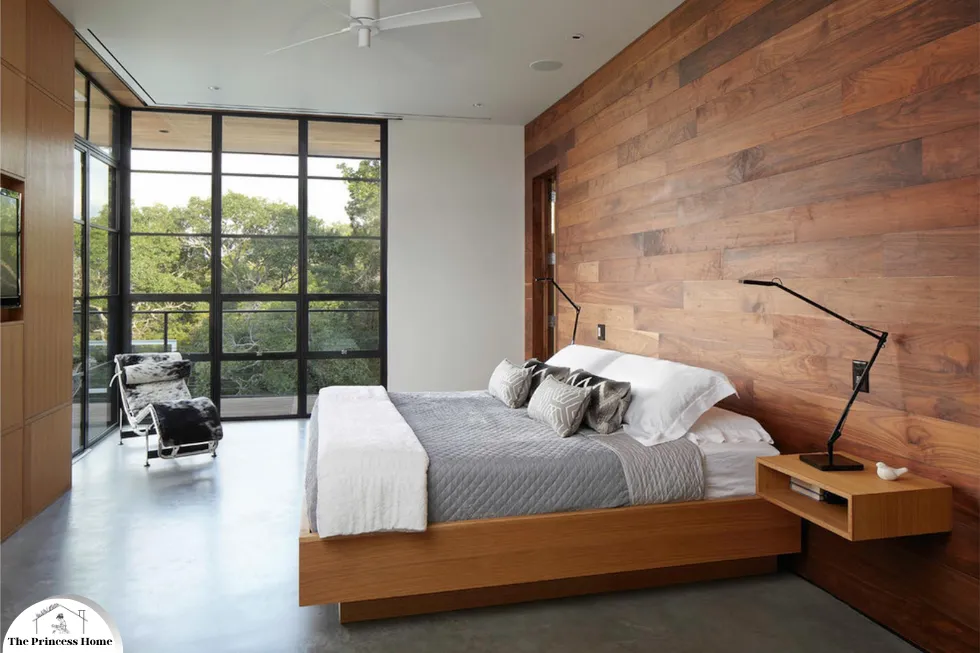
8.Natural Light:
Maximize natural light in your home to create a bright and airy atmosphere. Keep window treatments minimal to allow sunlight to filter in and illuminate your space, further enhancing the natural theme.
By incorporating dramatic colors, bold patterns, textured finishes, and metallic accents, you can create a statement wall that transforms the look and feel of the room, leaving a lasting impression on anyone who enters.

5*.Nature-Inspired Themes:
To infuse your living space with a calming and organic ambiance inspired by nature, consider incorporating the following elements:
1.Earthy Color Palette:
Choose feature colors reminiscent of the natural world, such as warm earthy browns, refreshing leafy greens, and serene ocean blues. These hues evoke feelings of tranquility and connection to the outdoors.
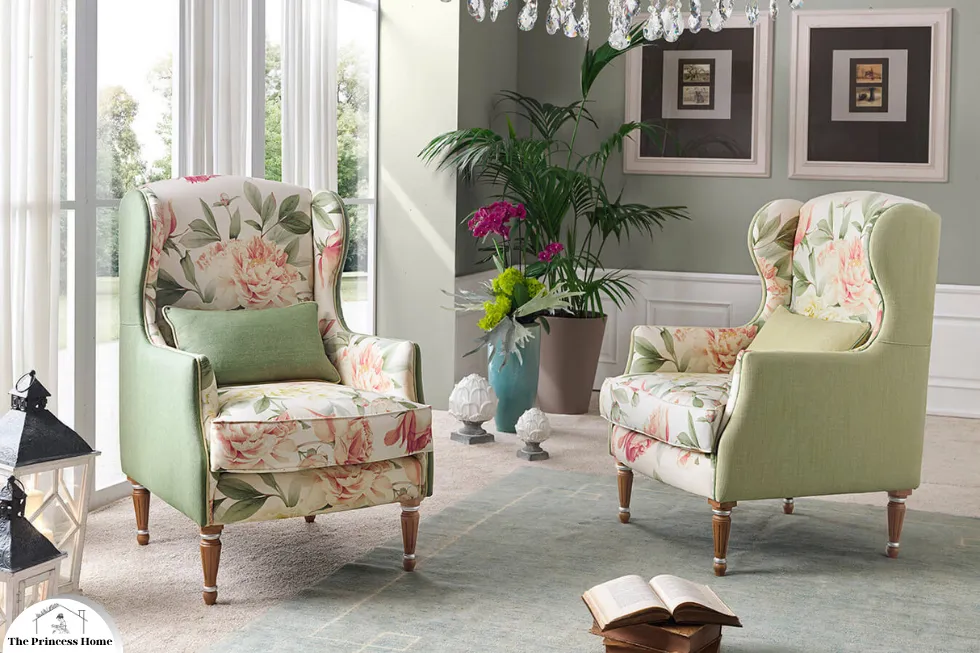
2.Botanical Prints:
Integrate botanical prints into your decor through upholstery fabrics, throw pillows, or curtains. Look for patterns featuring leaves, flowers, or branches to bring a touch of nature indoors.
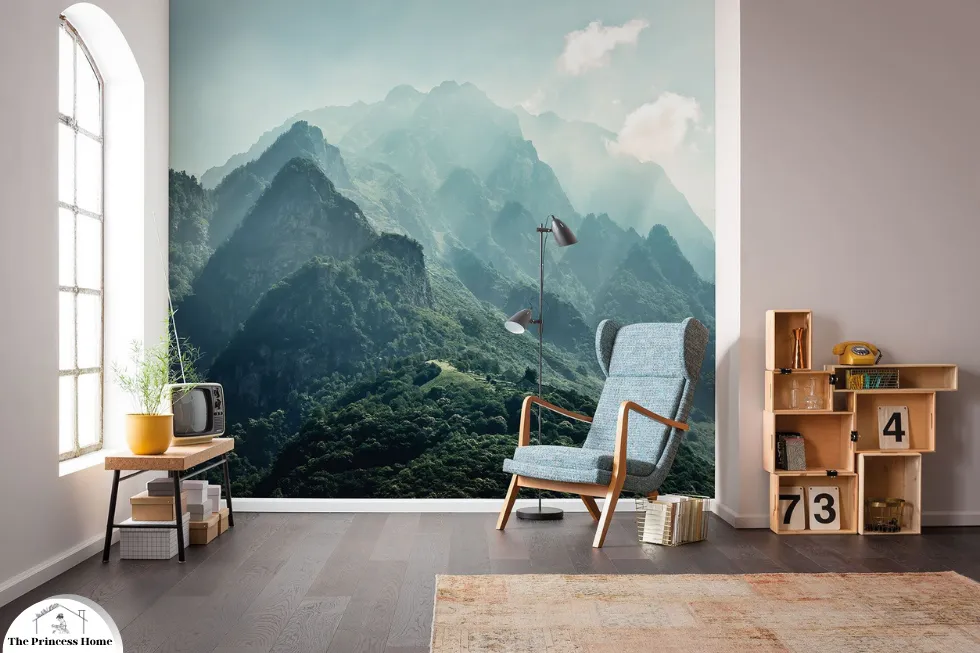
3.Nature-Inspired Wallpapers:
Consider using nature-inspired wallpapers to add visual interest and depth to your walls. Opt for designs featuring landscapes, forests, or floral motifs to create a serene backdrop reminiscent of the great outdoors.
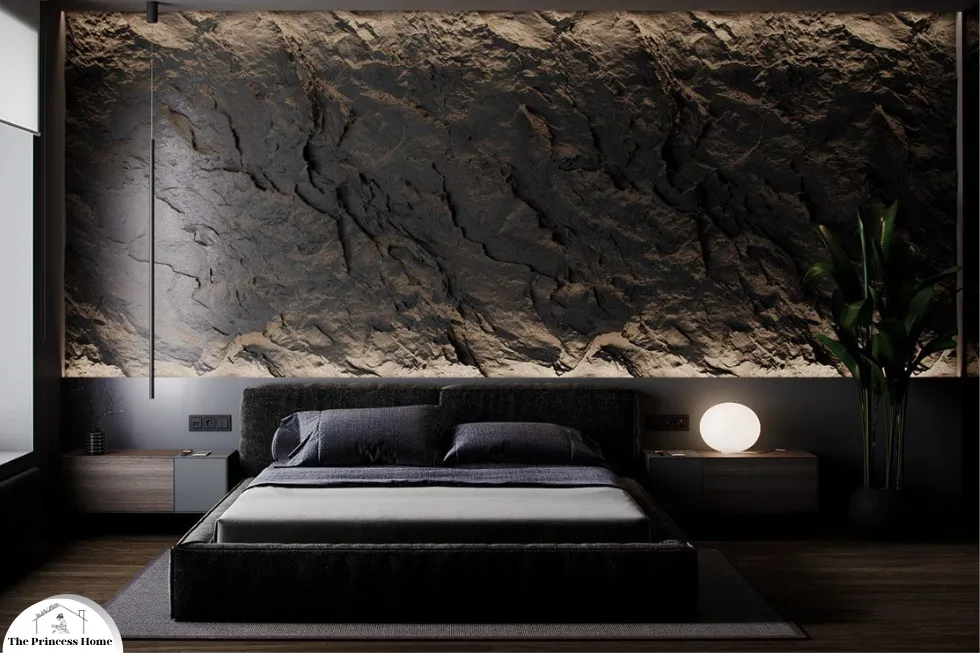
4.Natural Materials:
Incorporate natural materials such as wood, stone, or rattan into your furniture and decor. These elements add texture and authenticity to your space while reinforcing the nature-inspired theme.
By incorporating earthy colors, botanical prints, nature-inspired wallpapers, natural materials, indoor plants, natural light, and accessories from nature, you can create a serene and inviting living space that reflects the beauty and tranquility of the outdoors.
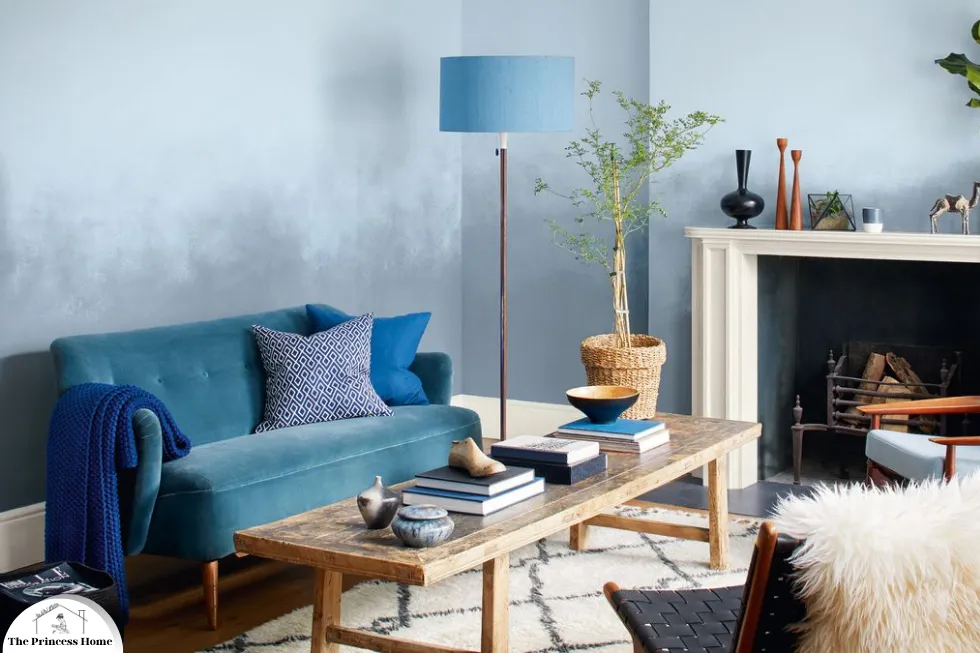
6*.Ombre Effects:
Create a subtle gradient effect by using varying shades of the same color on an accent wall. This technique adds visual interest and depth while maintaining a cohesive and harmonious look.
To achieve an ombre effect on an accent wall, follow these steps:
1.Choose Your Color Palette: Select a color palette consisting of varying shades of the same color. For example, you could choose different shades of blue for a calming effect or shades of pink for a more vibrant look.
2.Prepare Your Wall: Ensure that the wall you plan to paint is clean, smooth, and properly primed. Remove any furniture or decor from the area and cover the floor with a drop cloth to protect it from paint splatters.
3.Divide the Wall: Divide the wall into sections based on the number of shades you’ll be using. You can either use painter’s tape to mark off the sections or simply eyeball it for a more organic look.
4.Mix Your Paints: Mix each shade of paint according to the manufacturer’s instructions. You may need to dilute the paint slightly with water to achieve a smoother transition between shades.
5.Start Painting: Begin painting the wall, starting with the lightest shade at the top (or bottom) and gradually transitioning to the darkest shade at the opposite end. Use a large paintbrush or roller to apply the paint in long, smooth strokes.
6.Blend the Colors: As you move from one shade to the next, blend the colors together to create a seamless transition. You can do this by lightly overlapping the edges of each section with the adjacent shade and using a dry brush to feather out any harsh lines.
7.Step Back and Evaluate: Periodically step back and evaluate your progress to ensure that the ombre effect is coming together smoothly. Make any necessary adjustments to the blending or shading as you go.
8.Allow to Dry: Once you’ve finished painting, allow the wall to dry completely before removing any painter’s tape and reassembling the room.
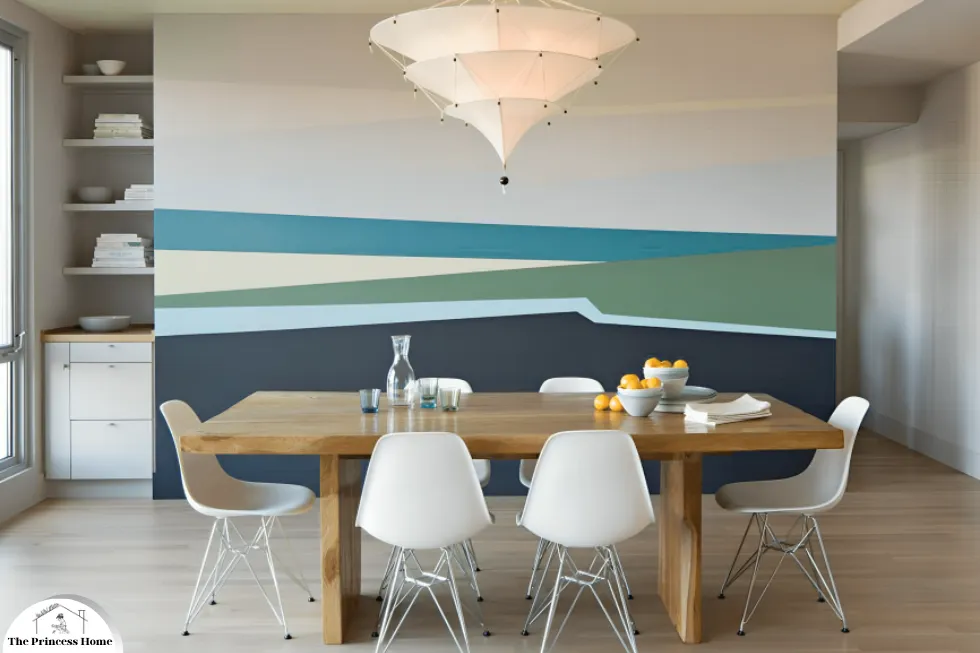
7*.Stripes and Patterns:
Experiment with stripes, chevrons, or other geometric patterns to add a playful and dynamic touch to your accent wall. Mix and match colors and widths for a personalized look.
To create an accent wall with stripes or other geometric patterns, follow these steps:
1.Plan Your Design:
Decide on the type of pattern you want to create, whether it’s classic stripes, chevrons, or another geometric design. Consider the scale of your wall and the effect you want to achieve.
2.Choose Your Colors:
Select colors that complement your existing decor and create the desired atmosphere in the room. You can use contrasting colors for a bold look or stick to varying shades of the same color for a more subtle effect.
3.Measure and Mark:
Use a level and measuring tape to mark the starting point of your pattern on the wall. For horizontal stripes, measure the desired width of each stripe and use painter’s tape to mark off the boundaries.
4.Paint the Base Coat:
Paint the entire wall with a base coat in one of your chosen colors. Allow it to dry completely before moving on to the next step.
5.Apply Painter’s Tape:
Once the base coat is dry, use painter’s tape to mask off the areas where you want the stripes or geometric pattern to appear. Make sure the tape is pressed firmly against the wall to prevent bleeding.
6.Paint the Stripes or Pattern:
Using a different color or colors, paint the exposed areas between the painter’s tape to create your desired pattern. For stripes, alternate between painting and masking off sections of the wall until you’ve completed the design. For chevrons or other geometric patterns, carefully paint within the taped-off areas according to your design plan.
7.Remove the Painter’s Tape:
While the paint is still slightly wet, carefully remove the painter’s tape at a 45-degree angle to ensure clean lines. If you wait until the paint is completely dry, you risk peeling off some of the paint with the tape.
8.Touch Up as Needed:
Once the paint is dry, inspect the wall for any imperfections or areas that may need touching up. Use a small brush to fix any mistakes or uneven lines.
By following these steps, you can create a playful and dynamic accent wall with stripes, chevrons, or other geometric patterns that add personality and visual interest to your space.
Conclusion:
Accent walls and feature colors are powerful tools in interior design, offering endless opportunities for creativity and expression. Whether you’re looking to create a focal point, add depth and dimension, or evoke a specific mood or atmosphere, these techniques can help you achieve your design goals with style and flair. By carefully selecting colors, textures, and patterns, you can transform any space into a visually stunning and inviting environment that reflects your personality and taste.
Certainly! Here are some frequently asked questions related to the article on accent walls and feature colors, along with their answers:
1.What is an accent wall?
An accent wall is a wall within a room that is painted or decorated differently from the other walls. It serves as a focal point, drawing attention and adding visual interest to the space.
2.How do I choose the right wall for an accent wall?
Choose a wall that naturally draws attention or serves as a focal point in the room, such as the wall behind a bed in a bedroom or the wall facing the entrance in a living room.
3.What are feature colors, and how do they differ from accent walls?
Feature colors are specific colors used to highlight architectural elements or create focal points within a space. While accent walls utilize color or design to create visual interest on one wall, feature colors can be applied to various elements throughout the room, such as trim, alcoves, or built-in shelving.
4.How can I incorporate accent walls and feature colors into a small space?
In small spaces, consider using lighter colors or subtle patterns to avoid overwhelming the room. Additionally, focusing on strategic placement, such as behind furniture or in alcoves, can help maximize impact without overpowering the space.
5.Are there any rules for combining colors and patterns on accent walls?
While there are no strict rules, it’s essential to consider the overall aesthetic of the room and ensure that colors and patterns complement rather than clash with each other. Experimenting with color swatches and visualizing the design beforehand can help in finding the perfect combination.
6.Can accent walls and feature colors work in any style of interior design?
Yes, accent walls and feature colors can be incorporated into various design styles, from contemporary to traditional and everything in between. The key is to adapt the colors, textures, and patterns to suit the aesthetic of the space while still achieving the desired visual impact.
7.How do I maintain balance when using bold colors or patterns on accent walls?
To maintain balance, consider incorporating neutral tones or simpler designs on the remaining walls and furniture. This helps to prevent the space from feeling overwhelmed and allows the accent wall to stand out without competing with other elements in the room.
8.Are there any cost-effective ways to create accent walls?
Yes, there are several cost-effective options for creating accent walls, such as using paint in strategic ways, applying removable wallpaper, or utilizing inexpensive materials like reclaimed wood or peel-and-stick tiles. These options provide flexibility and allow for easy updates or changes in the future.


